THE HISTORY OF THE CHAKRAS
"Go on a quest for the chakras, these mystical treasures hidden for millennia, where each discovery brings you closer to ancient and powerful wisdom.
Explore how these energy centers influence your physical, emotional, and spiritual well-being.
Embark on an adventure and let yourself be guided by unsuspected forces that could well change your destiny."
Written by Lionel Pradeau
Collapsible content
Reading time
About 15 min
THE CHAKRAS
According to the ancient philosophical beliefs of Hinduism, the 7 chakras reveal "energy centers", "spiritual centers" or "junction points of energy channels" located in the human body through which vital energy circulates, also called Chi or Qi in Chinese Feng Shui or Prana in India. They impact the harmony of the body and mind depending on whether they are open or closed, aligned or asymmetrical.
This energy flows from the bottom up, along the spine, from the sacrum (perineum region) to the fontanel (top of the skull), creating a global energy field. Each of the energy centers has its own color, vibrational frequency, and meaning.
Together, these energy centers generate emotional sources, survival instinct, self-confidence, the ability to love, and the ability to live happily. Here are their identities and meanings:
“Get inspired by the power of colors”!
Chakra Identity Card
First of all, a chakra is a subtle energy center in the body, where vital energy, called prana , circulates and is concentrated.
Each chakra is then associated with a specific color, a natural element, and a particular vibration, reflecting the psychological, physical, and spiritual aspects it influences. These colors range from red, symbolizing grounding and survival, to purple, representing enlightenment and divine connection.
Then we talk about the location of each chakra, which is an indication of its area of influence; they extend along the spine, from the tailbone to the top of the head, governing different aspects of our being, from material security to cosmic consciousness.
Finally, the state of each chakra is expressed by its balance or imbalance. A balanced chakra promotes harmony and well-being, while a blocked or overactive chakra can lead to emotional, mental, or physical imbalances. Chakra work, whether through meditation, yoga, or other energy practices, aims to harmonize these centers for overall alignment of body and mind.
To conclude this brief overview of chakras in general, we can say that each chakra plays an essential role in our overall health and spiritual development. Their harmony profoundly influences our life experience, setting us on a path of growth, healing, and self-realization.
Let's see all this!

No. 1 Red Chakra or Muladhara, the Root of Life
THE ROOT CHAKRA
At the heart of ancient traditions, Muladhara , the root chakra, is the foundation of our existence. In Sanskrit, "Muladhara" means "base" or "foundation," symbolizing stability and a deep connection to the Earth. This chakra is represented by a four-petaled lotus of deep, vibrant red, a color that evokes life force, passion, and survival.
Located at the base of the spine, Muladhara is the seat of primordial energy, the one that anchors us to the physical world and sustains our body in its material form. The red of this chakra is the color of blood, earth, and the fire that burns within us, symbolizing security, stability, and the need for survival.
In ancient Vedic texts, Muladhara is associated with the earth element, representing raw strength, security, and grounding. It is here that Kundalini resides, the dormant energy coiled like a serpent, ready to be awakened to rise through the chakras. Muladhara's red also reflects our most primal instincts, those that compel us to protect our bodies and minds.
Balancing this chakra is essential for feeling a sense of security, stability, and comfort in life. When Muladhara is in harmony, it gives us inner strength, unwavering determination, and a deep sense of belonging. However, when blocked, it can lead to fears, insecurities, and a sense of disconnection from the material world.
Ancient yogis used the sacred mantra "LAM" to activate and harmonize Muladhara, awakening life force energy and connecting it to the Earth. This chakra is also closely linked to survival, vitality, and physical energy. By balancing Muladhara, we strengthen our connection to the Earth, feel more grounded, and are prepared to face life's challenges.
Muladhara's red reminds us that, just as a tree needs deep roots to grow, we must be firmly grounded to reach our full potential. By cultivating the energy of this chakra, we lay the foundation for a stable and fulfilling existence, nourished by the life force that flows through us.
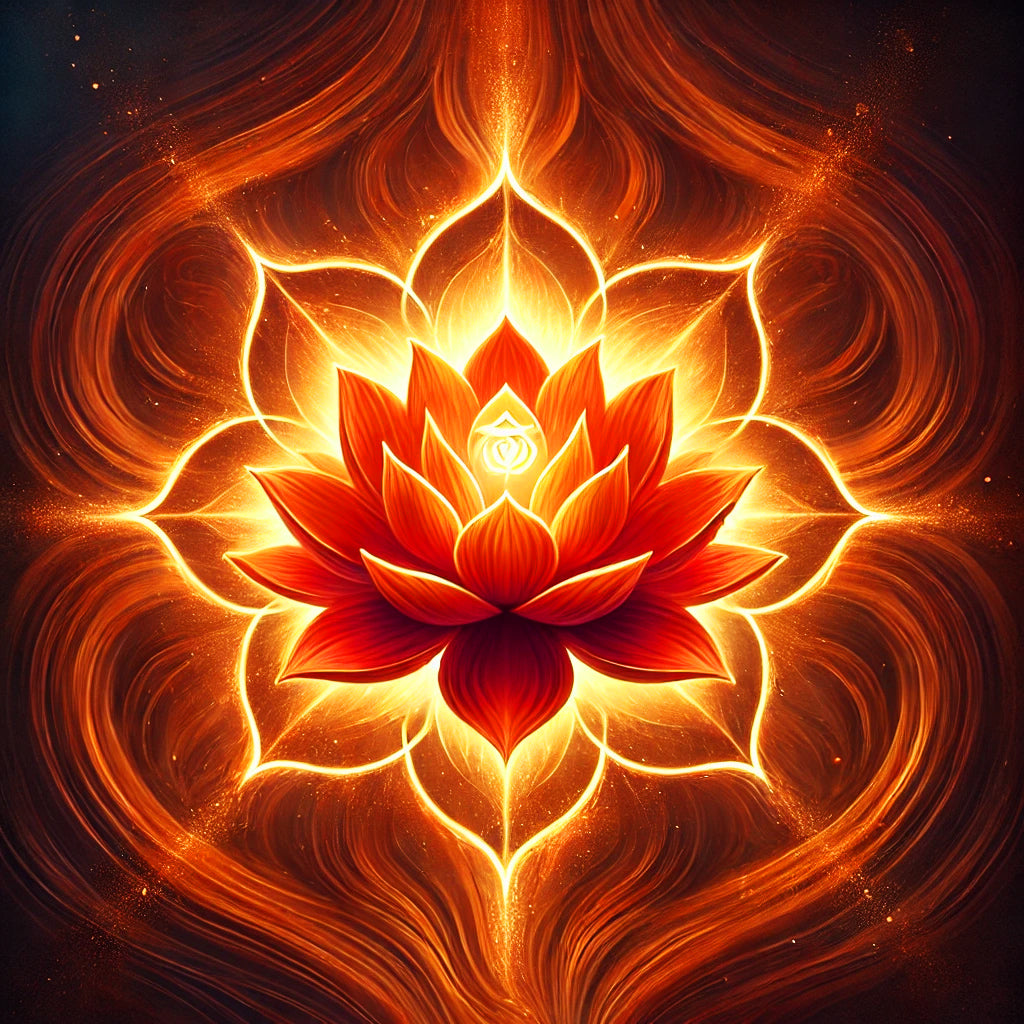
No. 2 Orange Chakra: Svadhisthana, the Ocean of Creativity
THE SACRAL CHAKRA
Steeped in the mysteries of ancient times, the Svadhisthana chakra , known in Sanskrit as "the abode of the self," is the energy center where the forces of creativity, sensuality, and desire mingle. This chakra, represented by a six-petaled lotus of vibrant orange, embodies the fluid energy of water, the element associated with this sacred center.
Svadhisthana is located just below the navel, where the power of creation resides, not only in a physical sense but also in an emotional and spiritual sense. The orange of this chakra is the color of dawn, the color that gently illuminates after the dark night, bringing with it the promise of transformation and renewal.
In ancient yogic texts, Svadhisthana is described as the seat of deep emotions and unconscious desires. It is here that Shakti , the divine feminine energy, resides in all her creative power. The gentle but constant fire of Svadhisthana fuels passions, dreams, and aspirations, while connecting us to life's pleasures, joy, and abundance.
By balancing this chakra, we open ourselves to the experience of life in all its sensory richness, cultivating our capacity to feel, love, and create. Ancient yogis used the sacred mantra "VAM" to harmonize Svadhisthana, thus activating the flow of creative energy that circulates through this center, while purifying stagnant emotions.
When Svadhisthana is in harmony, it unleashes a passionate life force, a desire to live each moment to the fullest, and boundless creativity. But when blocked, it can lead to fear of change, a loss of motivation, or a disconnection from the pleasure and joy of life.
Svadhisthana orange reminds us that, just as water flows and changes shape, our creative energy is fluid and constantly transforming. By embracing this energy, we learn to navigate the waters of life with grace and find a balance between passion, pleasure, and creation.
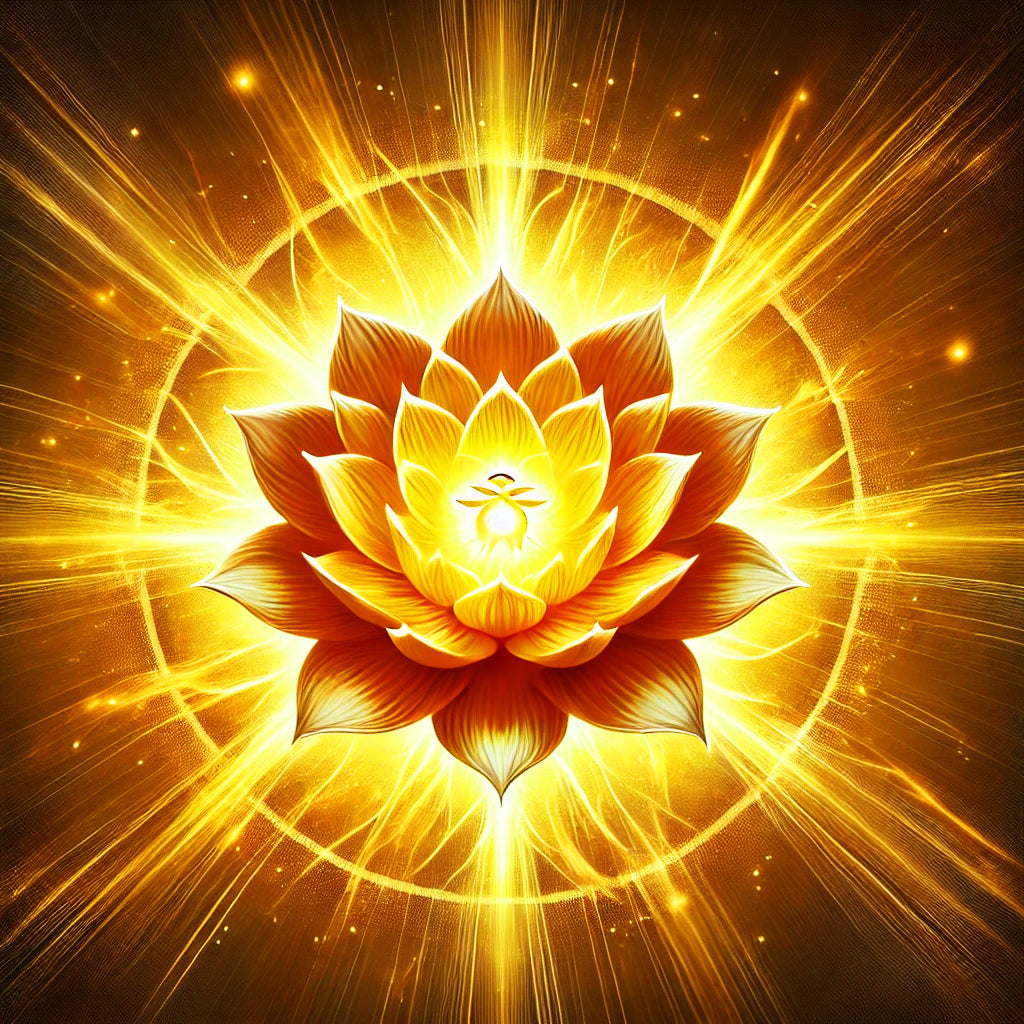
No. 3 Yellow Chakra: Manipura, the Inner Sun
THE SOLAR PLEXUS CHAKRA
At the heart of ancient Vedic teachings, the Manipura chakra , whose Sanskrit name means "city of jewels," shines like an inner sun, radiating power and light. This energy center, located at the level of the solar plexus, is symbolized by a ten-petaled, golden-yellow lotus, the color of mental clarity, willpower, and personal power.
Manipura is the home of dynamic energy and transformation, the place where the inner fire, Agni , burns intensely, fueling strength of character and determination. In ancient times, sages saw this chakra as the reservoir of vitality, the place where courage and self-confidence were forged, guiding the individual through life's challenges with unwavering assurance.
Manipura yellow evokes the power of the sun, the source of all life on Earth, and symbolizes the pure, radiant energy that emanates from within. This is where our ability to make decisions, exercise our personal power, and achieve our ambitions resides. Manipura connects us to our will to succeed, our ability to transform our intentions into actions, and to manifest our reality with confidence and conviction.
Ancient yogis used the sacred mantra "RAM" to awaken and balance Manipura, strengthening the inner flame and clearing energy blockages. This chakra is also associated with the element of fire, representing warmth, light, and purification—essential elements for personal transformation.
When Manipura is balanced, it gives us a sense of control, self-confidence, and dynamism, allowing us to shine brightly in all aspects of our lives. But when it is blocked, it can lead to feelings of doubt, indecision, or lack of motivation, extinguishing our inner fire.
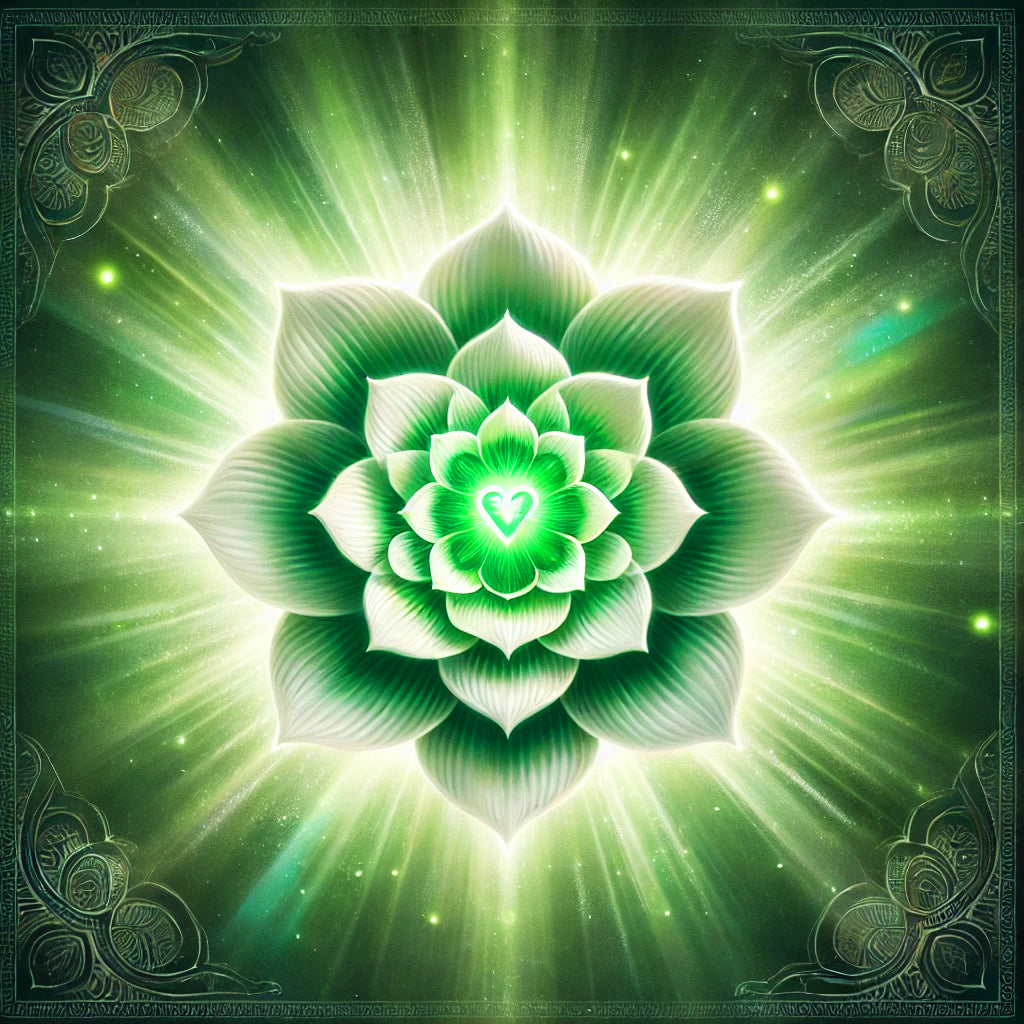
No. 4 Green Chakra: Anahata, the Awakened Heart
THE HEART CHAKRA
Deep within ancient yogic wisdom, the Anahata chakra , whose Sanskrit name means "unstruck" or "unwounded," is the energetic center of the heart, where universal love and infinite compassion reside. Symbolized by a twelve-petaled lotus of vibrant emerald green, Anahata is the sacred bridge that connects the physical and the spiritual, the individual and the universe.
Anahata green is the color of nature itself, representing healing, growth, and harmony. It is the living energy of the forest, the regenerative force of plants, the gentle breath of life. In Vedic traditions, this chakra is associated with the air element, symbolizing freedom and the flow of life energy, prana . Anahata is the seat of pure love, the love that transcends selfishness, opening the doors to acceptance, inner peace, and emotional balance.
The ancient sages taught that opening Anahata awakens within us the capacity to love unconditionally, to forgive, and to embrace life with unwavering tenderness. It is here that we feel the deep connection that unites us with all beings, transcending the boundaries of duality to access the unity of the heart. The sacred mantra "YAM" resonates in this chakra, like a gentle and healing vibration that harmonizes and balances our capacity to give and receive love.
When Anahata is balanced, it grants us deep inner peace, an ability to love authentically, and to live in harmony with ourselves and others. But when this chakra is blocked, it can lead to feelings of sadness, loneliness, or resentment, hindering our ability to make meaningful connections.
The emerald green of Anahata reminds us that love is the most powerful force in the universe, capable of healing, transforming, and uplifting the soul. By connecting with this sacred energy center, we learn to live with an open heart, ready to welcome the world with kindness and compassion.
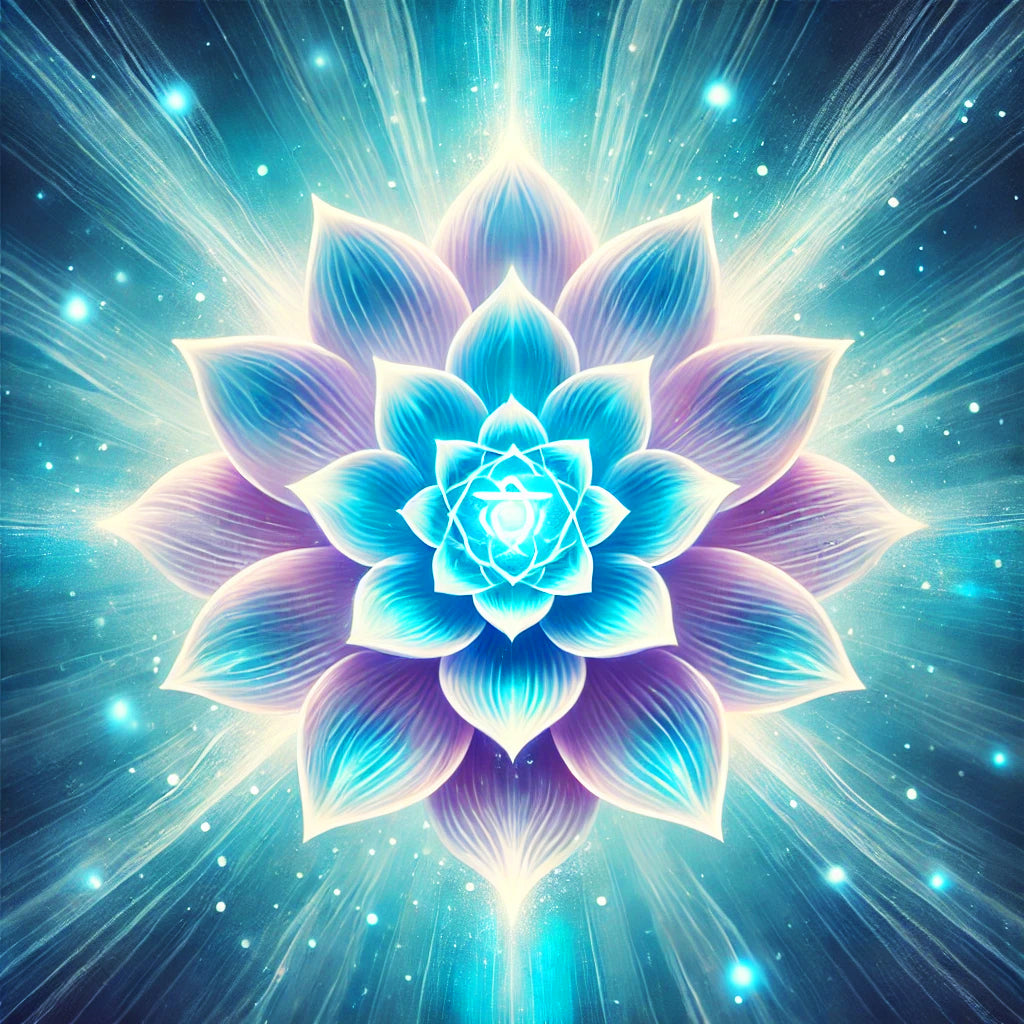
No. 5 Cyan Blue Chakra: Vishuddha, the Divine Voice
THE THROAT CHAKRA
Steeped in the mysteries of Sanskrit and ancient traditions, the Vishuddha chakra , whose name means "purification" or "purity," is the energetic center of communication and authentic expression. This chakra, symbolized by a deep azure blue sixteen-petaled lotus, embodies truth, wisdom, and the ability to express our purest essence. Located at the throat, Vishuddha is the sacred passageway through which we transform our thoughts into words, our ideas into actions, and our emotions into sounds.
Vishuddha blue is the color of the infinite sky and vast oceans, representing universal truth, tranquility, and spiritual awakening. In yogic texts, this chakra is associated with the ether element, or Akasha , the subtle essence that envelops and contains the entire universe. It is through Vishuddha that we learn to express our inner truth, communicate with clarity, and listen to the divine voice that resonates within us.
Ancient sages taught that activating Vishuddha unlocks the power of right speech, allowing the individual to transcend illusions and connect with universal wisdom. The sacred mantra "HAM" , resonating in this chakra, is a powerful vibration that purifies the throat and activates the flow of divine communication, aligning our expression with our true essence.
When balanced, Vishuddha gives us the confidence to speak with integrity, share our wisdom, and create deep connections through speech. However, when this chakra is blocked or imbalanced, it can lead to difficulty communicating, fears related to self-expression, or a tendency toward shyness or lying.
Vishuddha's azure blue reminds us that our voice is a sacred instrument, capable of creating, healing, and manifesting reality. By awakening this energy center, we learn to listen to our inner truth and share it with the world, honoring the divine power of speech.

No. 6 Indigo Blue Chakra: Ajna, the Eye of Inner Wisdom
THE THIRD EYE CHAKRA
Deep within ancient lore lies Ajna , the third eye chakra, a powerful energy center that embodies inner vision and intuitive perception. In Sanskrit, "Ajna" means "to perceive" or "to command," reflecting its crucial role in spiritual guidance and mental clarity. This chakra, symbolized by a deep indigo blue, two-petaled lotus, is located in the center of the forehead, between the eyebrows, and represents the gateway to divine wisdom and enlightenment.
Ajna's indigo blue is the color of twilight, that mysterious boundary between day and night, symbolizing intuition, higher consciousness, and access to unseen worlds. In yogic traditions, Ajna is associated with light and the mind; it is the seat of intelligence, intuition, and higher consciousness. It is also called the "eye of wisdom" or the "inner eye," as it is here that we develop the ability to see beyond appearances, understand hidden truths, and perceive reality beyond material illusions.
Ancient yogis taught that the awakening of Ajna opened the door to clear and profound insight, allowing the individual to transcend the limitations of the ordinary mind to access a higher consciousness. The sacred mantra "OM" , vibrated through this chakra, resonates throughout the being, aligning the mind with the universe and awakening the inner light of wisdom.
When Ajna is balanced, it allows for clear perception, keen intuition, and a deep connection with the higher self. It is the center of clairvoyance, premonition, and access to divine truth. However, when blocked or imbalanced, it can lead to mental confusion, a lack of perspective, or an inability to connect with one's intuition.
Ajna's indigo blue reminds us that beyond physical sight lies an infinitely more powerful inner vision, capable of piercing the veils of ignorance and revealing the true nature of reality. By activating this sacred center, we open ourselves to higher guidance and a deeper understanding of our place in the universe.
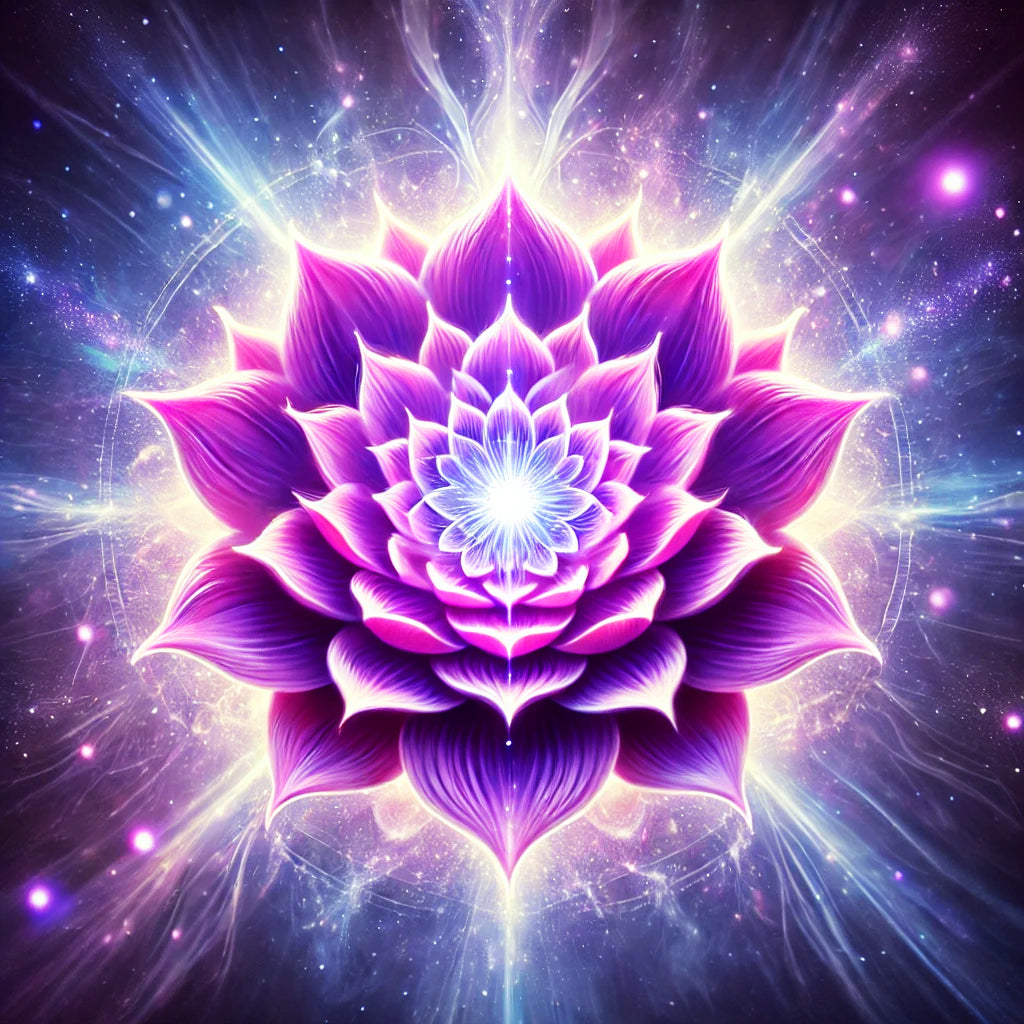
No. 7 Violet Chakra: Sahasrara, the Crown of Cosmic Consciousness
THE CROWN CHAKRA
At the apex of the yogic tradition is Sahasrara , the crown chakra, an energy center that embodies divine union and spiritual enlightenment. In Sanskrit, "Sahasrara" means "thousand-petaled," representing the crowned lotus that blooms atop the head, bathed in violet or white light. This chakra is the gateway to cosmic consciousness, the place where the individual connects with infinity, transcending duality and earthly limitations.
Sahasrara violet is the color of supreme spirituality, transformation, and universal wisdom. It is the hue that unites heaven and earth, symbolizing the connection between the individual self and the universal collective consciousness. In ancient times, sages considered Sahasrara to be the seat of enlightenment, where the soul merges with the divine, thus realizing its true potential and ultimate purpose.
Sahasrara is associated with pure consciousness, beyond the mind, beyond the body, a state of bliss where duality disappears and oneness with the whole reigns. Ancient yogis taught that awakening this crown chakra opened the way to spiritual liberation, allowing the individual to transcend the cycle of rebirth and access a state of higher consciousness. The sacred mantra "AUM" , or "OM" , is often used to activate Sahasrara, resonating throughout the universe and uniting the individual spirit with the cosmic vibration.
When Sahasrara is balanced, it brings a sense of deep peace, inner knowing, and connection with the universe. It is the center of divine wisdom, spiritual enlightenment, and pure consciousness. However, when it is blocked or imbalanced, it can lead to a sense of separation, spiritual confusion, or disconnection from the divine.
The luminous purple of Sahasrara reminds us that beyond our physical existence, there is an infinitely greater reality, where ultimate truth and eternal bliss reside. By activating this crown chakra, we open the way to the realization of our divine nature and union with infinity.
More articles from Valentine...
-

HATHA YOGA
DISCOVER THE ARTICLEExplore the harmony of Hatha Yoga, where each posture stabilizes the body and calms the mind in all its splendor.
-

VINYASA YOGA
DISCOVER THE ARTICLEDive into the flow of Vinyasa, where each breath guides a movement toward balance and energy.
-

COLOR SYMBOLIC
DISCOVER THE ARTICLEDive into the fascinating world of colors, where each shade tells a story, awakens emotions and influences our daily lives!
Valentine's Bio
-

VALENTINE
1994, Reunion Island, Mauritius, a Life carried by the Indian Ocean and Yoga
Since childhood, this intrepid traveler has traveled the globe, leaving her footprints on beaches around the world.Passionate about surfing, scuba diving and sailing, she has made the oceans her playground and source of inspiration.
The freedom of the waves, the serenity of the ocean depths and the wind in his sails have punctuated his journey, always guided by a quest for connection with nature.
It was through her explorations that yoga became more than a practice for her – it was a way of life.
Between early morning surf sessions and meditative sunsets, she found in yoga a perfect balance of strength, flow and self-awareness.
Today, she combines her passion for water sports with teaching yoga and is part of the Yogaterrae team, here in France, in the South West and often remotely :)
This adventurer is a true source of inspiration for anyone who aspires to live in harmony with their body and nature.
Through her stories of incredible experiences, she invites everyone to open up to a world where every wave, every breath and every posture is a celebration of life.







